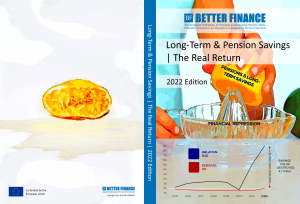 For 10 years now BETTER FINANCE points to the often-poor real net returns of long-term and pension savings (see the 2022 Edition of the Real Return) across a large number of EU jurisdictions. It is getting worse, and while a couple of years of poor performances can be made up for, the same can’t be said for 22 years.
For 10 years now BETTER FINANCE points to the often-poor real net returns of long-term and pension savings (see the 2022 Edition of the Real Return) across a large number of EU jurisdictions. It is getting worse, and while a couple of years of poor performances can be made up for, the same can’t be said for 22 years.
(➡️ Watch the video: "The Real Return: 10 years of reporting on the state of long-term & pension savings in Europe")
Since the change of the millennium French unit-linked life insurances lost 8.4% of the real value of contributions, while a Latvian worker enrolled in an occupational pension fund (Pillar II) earned a measly cumulative +1% real net return over the last 19 years.
One could argue that when markets perform poorly, so do pension savings. However, Swedish workers enrolled in the default occupational pension fund (AP7 Safa) since 2001, enjoyed a five-fold (+482%) multiplication of their investments.
What are the main factors for these too-often poor results?
Inflation: The Enemy Hidden in Plain Sight
Over the years, the cumulative effect of inflation in the EU27 caused for €100 in 2000 to be worth just €64 by 2021, explaining the too often poor real net returns BETTER FINANCE draws attention to each year. In 2021 the situation took a turn for the worse and inflation started to skyrocket, reaching 10% in September 2022. Eurozone inflation is optimistically forecasted to decrease gradually from 6.78% in Q4 this year to 3.94% in the same quarter next year, in any case well above the ECB’s 2% target. However, inflation has been underestimated for all three quarters so far: 3% instead of 7.4%; 6% instead of 8.6%; 7.3% instead of 10%.
Fees
It is an almost impossible task to aggregate full and comparable data on costs and charges across the pension systems we analyse. Most of our data comes from supervisors only reporting net returns, making it difficult to proxy gross returns. However, when compared to capital market returns, which bear no costs, only four outperformed EU capital markets out of the 41 vehicles analysed in our report.
“Financial Repression” taxes today’s Savings and tomorrow’s Pensions
Far more damaging still than inflation for EU savers is “financial repression”. This is how economists call the public policies channeling savings to Government funding and ensuring that nominal interest rates are kept below or much below inflation rates. The magnitude of financial repression can be illustrated by the difference between the inflation and the Central Bank nominal interest rate. Over the last ten years, the EU entered an era of financial repression, which is reaching historical highs this year.
[...]
- Read the full press release below
